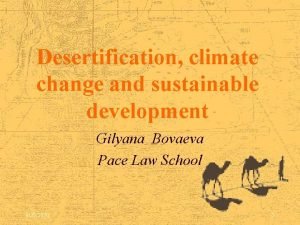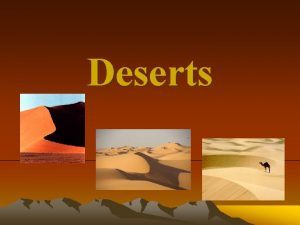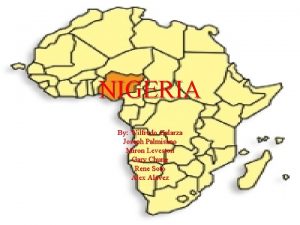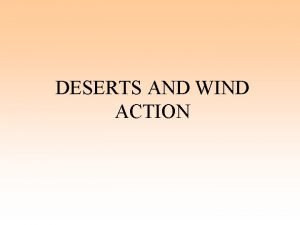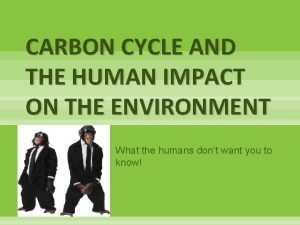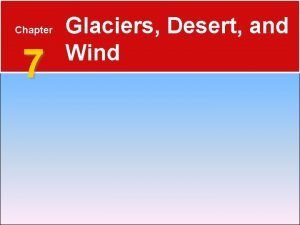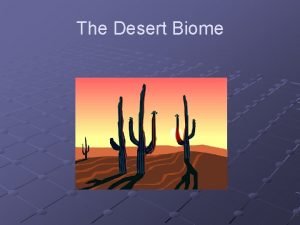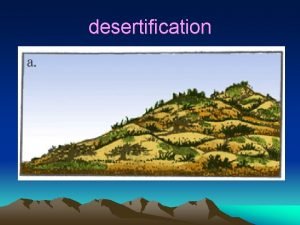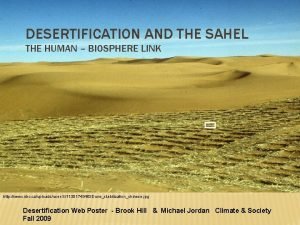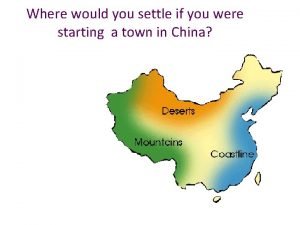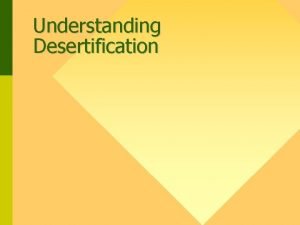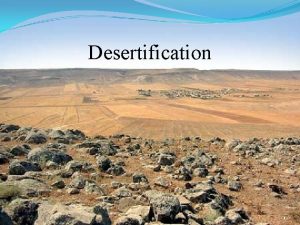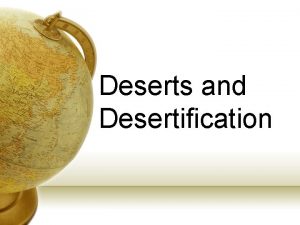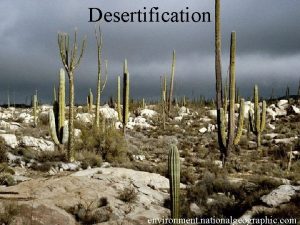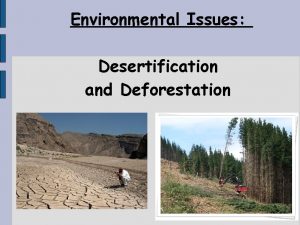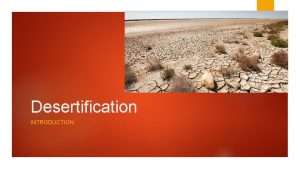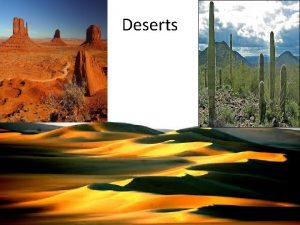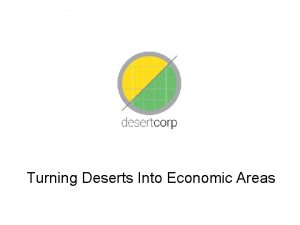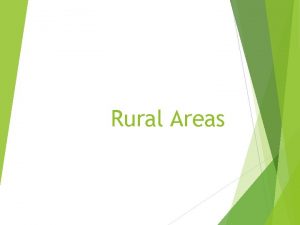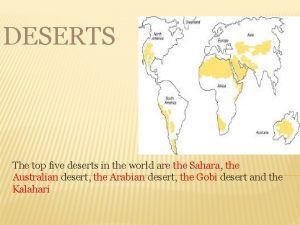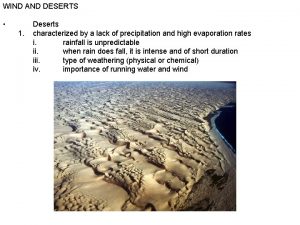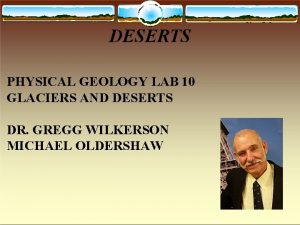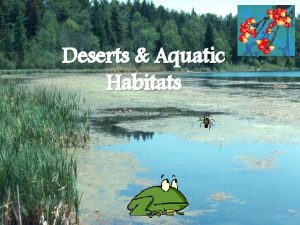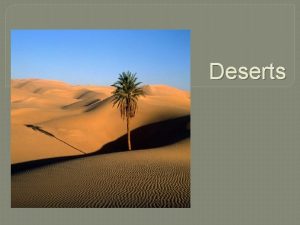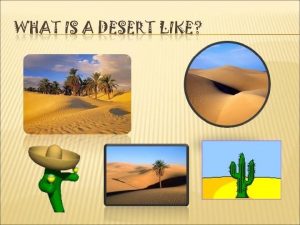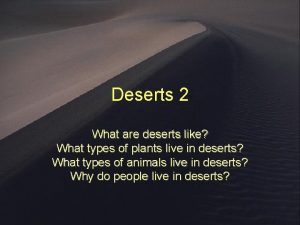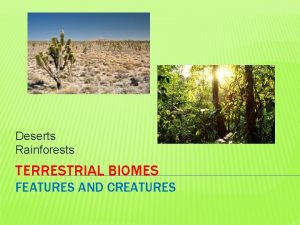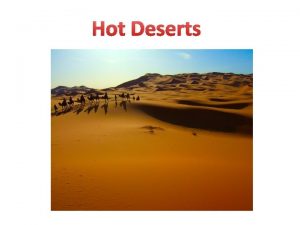Desertification 1 Desertification Deserts areas of low rainfall





















- Slides: 21

Desertification 1

Desertification Deserts: areas of low rainfall…. . Arid: less than 10 cm (4 in) Semi-arid: less than 25 cm (10 inches) Desertification: the degradation of land in arid, semi-arid, and dry sub-humid areas. Can be caused by human activity or naturally occurring phenomenon. 2

Desertification Causes of Desertification: Complex interplay of physical and ecological processes, and developmental and socioeconomic forces. For example: a. brief period of excess rainfall “the rain follows the plow” b. over irrigation (salinization) c. ground-water depletion 3

Desertification …is the degradation of land in arid, semi-arid, and dry sub-humid areas. 1. Causes of Desertification: Complex interplay of physical and ecological processes, and developmental and socioeconomic forces. 2. Drought: rainfall significantly below normal for an extended period. a. several years b. more than 25% less than normal 4

Drylands cover about 40% of Earth’s land surface Home to more than 38% of the total global population of 6. 5 billion (about 2. 4 billion) Land degradation is present on 10 to 20% of the global drylands Land degradation indirectly affects about 250 million people in the developing world

Dryland regions of the world (yellow) these are sensitive to desertification 6


BIOGEOMORPHIC the physical geography of arid lands transitional region between savanna and desert variability in precipitation natural vegetation

Desertification Excessive forest clearing and overgrazing livestock reduces vegetation cover. Two impacts: 1. *Albedo increases: cooling the region in summer and weakening monsoon circulation. 2. Less vegetation = less evapotranspiration. So less water vapor in the atmosphere to fuel precipitation over the region. Albedo is the fraction of solar energy (shortwave radiation) reflected from the Earth back into space 9

From Lancaster, 2007

Desertification in the US 30% of the land in the U. S. is affected by desertification. 11

12

13

14

15

Precursers 10 -fold increase in population between 1860 and 1920. Deep plowing and monoculture destroyed soil structure and increased sensitvity to erosion. Additional factors: Great Depression: no $ for prairie farmers Out migration “Okies” True drought. 16

17

Desertification in the US: The Dust Bowl of the 1930 s. Changed farming practices & plowing techniques 1. 2. 3. 4. Shallow, rather than deep, along contours Established windbreaks Crop rotation Irrigation 18

Phoenix, Arizona in the early 1970 s 19

20

How have each of these factors contributed to desertification? desertification climate humans animals
 Reflective communication style
Reflective communication style High precision vs high accuracy
High precision vs high accuracy Low voltage = low hazard
Low voltage = low hazard Mid low high
Mid low high Introduction of desertification
Introduction of desertification What is deserts
What is deserts Rain shadow deserts
Rain shadow deserts Characteristics of deserts
Characteristics of deserts Nigerian deserts
Nigerian deserts How were deserts formed
How were deserts formed Deserts cover about
Deserts cover about How were deserts formed
How were deserts formed Desertification effects on humans
Desertification effects on humans Chapter 7 glaciers deserts and wind
Chapter 7 glaciers deserts and wind Biome desert location
Biome desert location Desertification conclusion
Desertification conclusion Factors of desertification
Factors of desertification Desertification cause
Desertification cause The huang he flows to the __________.
The huang he flows to the __________. Conclusion of desertification
Conclusion of desertification Conclusion of desertification
Conclusion of desertification Food deserts in minnesota
Food deserts in minnesota




